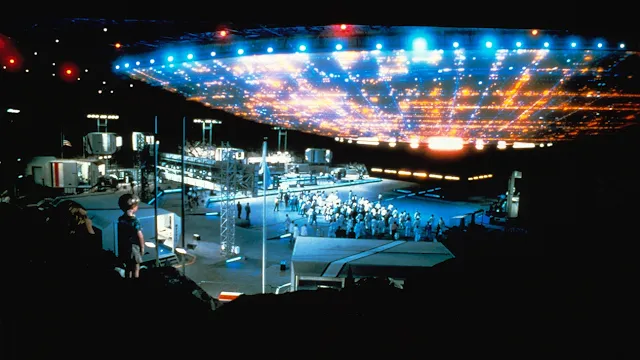"Close Encounters of the Third Kind," directed by Steven Spielberg and released in 1977, explores the concept of communication and the possibility of contact with extraterrestrial beings.
Music plays a pivotal role throughout the film, particularly in the finale, where humans and aliens communicate through a unique form of musical dialogue.
This discussion will delve deeper into the diegetic music in the film's final sequence, examining how it enhances the narrative and highlights the universal language of music.
The Mysterious Five-Note Motif:
From the very beginning of the film, a mysterious five-note musical motif captivates the audience and serves as a central element in "Close Encounters of the Third Kind." This iconic motif, composed by John Williams, perfectly captures the enigma surrounding the extraterrestrial signal. Spielberg and Williams collaborated closely to create a motif that felt otherworldly yet memorable, evoking a sense of mystery and intrigue.
The Musical Dialogue:
The final sequence of the film takes place at the awe-inspiring location of Devils Tower in Wyoming. As the spacecraft arrives, the film reaches its climactic moment, and a mesmerizing musical dialogue unfolds between the humans and the aliens. The humans, led by the protagonist Roy Neary (played by Richard Dreyfuss), initiate the conversation by playing the five-note motif on a synthesizer. This reaches a frenzy as the aliens respond in kind, leading to meaningful communication.
The response from the extraterrestrial visitors is a complex and intricate sequence of musical tones and patterns. The music they produce showcases their advanced understanding and proficiency, suggesting a level of intelligence beyond human comprehension. This musical exchange beautifully emphasizes the universal language of music as a means of communication that transcends linguistic and cultural barriers.
During the filming of the finale, Spielberg and the production team faced the challenge of making the musical conversation between humans and aliens visually compelling. To achieve this, they employed a variety of lighting effects and practical techniques. The lighting and the spacecraft's illumination were synchronized to the music, enhancing the overall impact of the scene and creating a sense of harmony between the visuals and the diegetic music.
John Williams' score for "Close Encounters of the Third Kind" masterfully captures the wonder and mystery of the film's narrative. In the finale, his music takes on an even more profound role by representing the transformative power of music itself. Through the mesmerizing musical conversation, the film illustrates how music transcends language and fosters unity among disparate beings.
The use of music in the film's finale conveys a profound sense of awe, unity, and shared experience. As the humans and aliens exchange musical ideas, a sense of curiosity and wonder fills the air. The common ground found through music becomes a metaphor for overcoming differences and discovering harmony, both in the literal sense of the interaction between species and on a more symbolic level, reflecting the potential for connection and understanding between humans themselves.
To achieve a seamless integration of the diegetic and non-diegetic music, John Williams and the sound design team meticulously crafted the soundscape of the finale. The music played by the humans on the synthesizer was recorded live on set, ensuring authenticity and creating a genuine interaction between the actors and the music. This live recording provided a foundation for Williams to compose the accompanying score, further enhancing the emotional impact of the scene.
"Close Encounters of the Third Kind" presents a unique and memorable portrayal of communication through music in its captivating finale. The diegetic music, particularly the enigmatic five-note motif, serves as a pivotal element in depicting the extraordinary form of interaction between humans and aliens. This iconic sequence demonstrates the universal power of music to transcend barriers
















